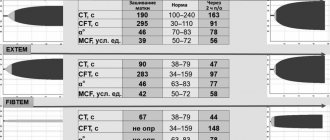Erythremia is a tumor clonal disease of the hematopoietic system, in which there is proliferation of erythroid, granulocytic and megakaryocytic lineages of hematopoiesis with predominant activation of erythropoiesis. At the same time, an increase in the level of red blood cells and hemoglobin, thrombocytosis and leukocytosis is noted in the blood. Almost all patients with erythremia are carriers of the JAK2V617F mutation.
- How does erythremia develop?
- Symptoms of erythremia
- Stages of erythremia
- Diagnosis of erythremia
- Treatment of erythremia
- Prognosis for erythremia
How does erythremia develop?
The causes of erythremia are still unknown. It is believed that this is a multi-stage disease in which, under the influence of external factors, the genome of a normal cell is damaged, which leads to its malignant transformation and the formation of a tumor cell clone that replaces normal hematopoiesis.
Almost all patients have a mutation in the JAK2 gene. Exon 14 is usually affected; 90-96% of patients have the V617F mutation. 2% of patients have mutations in exon 12. Damage to other genes, in particular MPL, CALR, is very rarely detected. All of these genetic pathologies are specific to erythremia, so their determination is necessary to confirm the diagnosis.
So, molecular genetic disorders cause activation of the JAK-STAT signaling pathway, which leads to increased proliferation of hematopoietic sprouts and an increase in the number of blood cells.
Monocytes and megakaryocytes (platelet precursors) produce a variety of cytokines - biologically active molecules that stimulate fibrotic changes, the formation of new blood vessels, which ultimately leads to osteosclerosis and bone marrow fibrosis. In addition, massive production of cytokines contributes to the development of tumor intoxication, which aggravates the general condition of patients.
There is also a disruption in the connection of stem cells with the microenvironment. This provokes the formation of foci of hematopoiesis outside the bone marrow. The liver and spleen are primarily affected.
Symptoms of erythremia
Clinically, erythremia manifests itself in two syndromes:
- Plethora (plethora). This syndrome is characterized by an increase in the number of circulating red blood cells. Symptomatically manifested by headaches, dizziness, attacks of rapid heartbeat, itchy skin and visual disturbances. The skin and mucous membranes have a bluish tint. Vascular complications are also possible: thrombosis, erythromelalgia (redness of the fingers, pain and burning sensation in them).
- Myeloproliferative syndrome - develops as a result of hyperplasia of hematopoietic germs. Symptomatically manifested by weakness, fever, sweating, itchy skin, bone pain. With the breakdown of granulocytes, a disturbance in urate metabolism is observed, which leads to the development of gout, kidney stones and urate diathesis.
Stages of erythremia
During its development, erythremia goes through several stages. The first, also known as initial, can last more than 5 years. During this period, moderate manifestations of plethoral syndrome are mainly present. The blood test shows moderate erythrocytosis, and in the bone marrow there is an increase in the proliferation of all hematopoietic lineages with the exception of the lymphocytic lineage. The spleen is not enlarged, complications rarely develop.
The second stage of erythremia is polycythemia. It is divided into 2 substages A and B. Stage A lasts 5-15 years. It is characterized by an increase in the number of formed elements in the blood. As a result, a pronounced plethoric syndrome is formed, which is complicated by thrombosis, bleeding, and an increase in the size of the liver and spleen. In the blood test, cytosis increases; in the bone marrow, in addition to the proliferation of erythropoietic, granulocytic and thrombopoietic lineages, cicatricial changes are noted.
With erythremia in stage B, cytosis and clinical symptoms continue to increase. Foci of tumor growth form in the spleen, and cicatricial changes progress in the bone marrow.
Stage 3 of erythremia - anemic. Here, bone marrow fibrosis already develops, which leads to its depletion and a decrease in the level of blood cells. The disease can transform into acute leukemia.
The second stage of development of erythremia
In the second stage, a complete picture of the disease develops with the addition of thrombocytosis to erythremia.
Excessive plethora is characterized by a rich red color of the skin, redness of the conjunctiva of the eyes and, characteristic of erythremia, a sharp border between the pallor of the hard palate and the cherry color of the soft palate. A pronounced vascular network appears on the tip of the nose and cheeks.
General symptoms may include sweating, weight loss, persistent low body temperature, and night bone pain.
Characterized by intolerance to heat and, as an extreme degree of its manifestation, heat. Unbearable body itching and excruciating pain in the fingers and toes appear. The cold makes the condition much easier.
Spontaneous widespread urticaria often occurs on the skin of patients with erythremia, and hemorrhages appear due to rupture of overcrowded vessels.
The spleen enlarges, in one case, as a result of the development of additional islands of hematopoiesis in it, in another case, or in parallel, as a result of its overflow with blood and the development of multiple infarctions in it, which can be felt by the patient in the form of heaviness and some pain in the left hypochondrium.
During this period of the disease, thrombosis and complications of thrombosis often occur.
Diagnosis of erythremia
As part of the diagnosis of erythremia, the patient undergoes a comprehensive examination, which includes the following measures:
- Anamnesis and physical examination, during which the color of the skin of the face and extremities is assessed. The size of the liver and spleen must be determined.
- A detailed blood test, including counting the number of blood cells and erythrocyte indices.
- Trephine biopsy of the bone marrow followed by histological and histochemical examination.
- Determination of erythropoietin level.
- Molecular genetic testing for the presence of specific V617F mutations.
- Ultrasound of the liver and spleen to accurately determine their size.
The diagnosis of erythremia is made according to the 2021 WHO criteria, which distinguishes three major criteria and one minor one.
Major criteria for erythremia:
- The hemoglobin level is more than 160 g/l in women and more than 165 g/l in men.
- Hyperplasia of three myelopoiesis lineages in bone marrow trephine.
- The presence of a mutation in the JAK2 gene.
A minor criterion is a decrease in erythropoietin levels.
To make a diagnosis of erythremia, it is necessary either to have all three major criteria, or 1-2 major and one minor.
Treatment of erythremia
The main goals of treatment for erythremia are:
- Preventing the formation of blood clots and treating already developed thrombosis and thromboembolism.
- Reducing the level of tumor intoxication and controlling associated symptoms (fever, itching, weight loss).
- Reducing the risk of transformation into acute myeloid leukemia or myelofibrosis.
- Preventing the development of complications if surgical interventions or pregnancy are necessary.
To assess the likelihood of developing thrombosis during erythremia, risk stratification is carried out according to the following criteria:
- Age over 60 years.
- Presence of thrombosis in the past.
- Cardiovascular risk factors: arterial hypertension, excess weight, diabetes, physical inactivity.
If the patient does not have the listed factors, then he is classified as a low-risk group, in the presence of cardiovascular factors - as an intermediate one, and if he is over 60 years old and/or has a history of thrombosis, he is considered to be at high risk of thromboembolic complications. The platelet level does not affect the risk of thrombosis, but it plays a certain role in the development of bleeding. To prevent the development of thrombosis, it is necessary to eliminate cardiovascular risk factors, as well as prescribe antiplatelet agents.
In addition, the following methods are used to treat erythremia:
- Removing excess red blood cells in the blood. It can be carried out either using hemoexcursion (regular bloodletting) or erythrocytepheresis (removal of red blood cells directly).
- Cytoreductive therapy. Cytostatics and interferons are used.
- Treatment of complications of already developed thrombosis.
Hemoexcursions (bloodletting) for erythremia
Bloodletting is used to reduce the volume of circulating blood. The volume of hemoexcursion is 250-500 ml per procedure, after which the missing volume of fluid is replenished with saline solution. Or the second option is a preliminary infusion of antiplatelet agents together with saline in a volume exceeding the volume of blood removed. Sessions are carried out every other day until the hematocrit reaches 40-45%. For elderly patients, sessions are performed 2 times a week, or the volume of blood excursion is reduced.
Erythrocytopheresis
Erythrocytapheresis refers to methods of extracorporeal detoxification, which replaced bloodletting. It is based on the removal of red blood cells, followed by the return of plasma and replenishment of the volume with solutions of crystalloids or colloids. In one session, up to 400 ml of red blood cells can be removed.
Acetylsalicylic acid preparations
Acetylsalicylic acid, or aspirin, is prescribed to prevent thrombotic complications. Aspirin should be prescribed to every patient with erythremia unless there are contraindications. If they are present, clopidogel or ticlopidine is prescribed.
Cytoreductive therapy
Hydroxyurea
Theoretically, hydroskiurea can be used as part of first-line therapy in patients of any age. But due to the fact that it is genotoxic and can provoke a leukemic effect, such first-line treatment is not recommended for patients under 50 years of age and pregnant women. It is also necessary to discontinue treatment in case of intolerance and ineffectiveness of therapy. The criterion for intolerance to hydroxyurea is the presence of at least one of these symptoms:
- Exceeding the hematocrit by more than 45% 3 months after treatment with hydroxyurea at a dosage of 2000 mg/day.
- Lack of control of myeloproliferation. This may be indicated by a platelet level of more than 400×10 9 and a leukocyte level of more than 10×10 9 after 3 months of treatment.
- Presence of an enlarged spleen (more than 10 cm below the costal margin) or the inability to eliminate the symptoms of splenomegaly.
- Myelopenia when using minimal dosages of drugs - platelet level below 100×10*9 or hemoglobin below 100 mg/l.
- Ulcers on the legs.
- Damage to the skin and mucous membranes.
- Disruption of the gastrointestinal tract.
- Pneumonitis.
- Fever.
Interferon alpha
Interferon alfa is highly effective against erythremia and allows a molecular response to be achieved in some patients. It also relieves plethoral syndrome well, reducing the severity of itching. However, its widespread use is limited by poor tolerability. It is mainly recommended for patients under 50 years of age.
Busulfan
With the help of busulfan, active control of erythremia is possible, however, with long-term use, the risk of developing secondary leukemia increases. Therefore, it is used in patients over 70 years of age with intolerance to hydroxyurea and interferons.
Leukemia – Erythremia (Vaquez disease)
Ichilov Hospital / BLOOD CANCER / Leukemia – Erythremia (Vaquez disease)
Erythremia (Vaquez disease, polycythemia vera)
- chronic leukemia, belongs to the group of benign tumors of the blood system.
The tumor grows into all hematopoiesis, especially erythroid, which is accompanied by an increase in the number of red blood cells (in some cases, leukocytes and platelets), hemoglobin, mass and viscosity of circulating blood, and increased blood clotting.
Erythremia occurs mainly in old age. For many years, erythremia may not manifest itself in any way. If it occurs in young people, which is very rare, the picture is much more serious.
There are 3 stages of the disease:
initial,
expanded (erythremic),
terminal.
initial stage
In the initial stage, patients usually complain of heaviness in the head, tinnitus, dizziness, increased fatigue, decreased mental performance, chilly limbs, and sleep disturbances.
External characteristic signs may be absent.
Expanded stage
The advanced (erythremic) stage is characterized by the development of vivid symptoms.
Headache
The most common and characteristic symptom is headaches, sometimes in the nature of painful migraines with blurred vision.
Many patients complain of pain in the heart, sometimes like angina pectoris, pain in the bones, in the epigastric region, weight loss, blurred vision and hearing, unstable mood, and tearfulness.
Itchy skin
A common symptom of erythremia is skin itching. There may be paroxysmal pain in the tips of the fingers and toes. The pain is accompanied by redness of the skin.
Upon examination, attention is drawn to the special red-cyanotic color of the skin with a predominance of dark cherry tone. Redness of the mucous membranes (conjunctiva, tongue, soft palate) is also noted. Due to frequent thrombosis of the extremities, darkening of the skin of the legs and sometimes trophic ulcers are observed. Many patients complain of bleeding gums, bleeding after tooth extraction, and bruises on the skin.
In 80% of patients, there is an enlargement of the spleen: in the advanced stage it is moderately enlarged, in the terminal stage severe splenomegaly is often observed.
Usually the liver is enlarged.
Often in patients with erythremia, increased blood pressure is detected.
As a result of malnutrition of the mucous membrane and vascular thrombosis, ulcers of the duodenum and stomach can occur.
Vascular thrombosis plays an important role in the clinical picture of the disease. Thrombosis of the cerebral and coronary arteries, as well as the vessels of the lower extremities, is usually observed. Along with thrombosis, patients with erythremia are prone to the development of hemorrhages.
Terminal stage
In the terminal stage, the clinical picture is determined by the outcome of the disease - liver cirrhosis, coronary thrombosis, a softening focus in the brain due to thrombosis of cerebral vessels and hemorrhages, myelofibrosis accompanied by anemia, chronic myeloid leukemia and acute leukemia.
TREATMENT OF ERYTHREMIA
In the advanced stage of erythremia, cytostatic therapy is indicated.
The most effective cytostatic drug in the treatment of erythremia is imifos. The drug is administered intramuscularly or intravenously at a dose of 50 mg daily for the first 3 days, and then every other day. For a course of treatment - 400-600 mg. The effect of imiphos is determined after 1.5-2 months, since the drug acts at the bone marrow level. In some cases, anemia develops, which usually gradually disappears on its own. In case of an overdose of imiphos, hypoplasia of hematopoiesis may occur, for the treatment of which prednisolone, Nerobol, vitamin B6 and B12, as well as blood transfusions are used.
The average duration of remission is 2 years; maintenance therapy is not required. When the disease relapses, sensitivity to imiphos remains.
With increasing leukocytosis and rapid growth of the spleen, myelobromol 250 mg is prescribed for 15-20 days. Myelosan is less effective in the treatment of erythremia.
Anticoagulants, antihypertensive drugs, and aspirin are used as symptomatic treatments for erythremia.
Forecast
relatively favorable. The total duration of the disease in most cases is 10-15 years, and in some patients it reaches 20 years.
Vascular complications, which can cause death, as well as transformation of the disease into myelofibrosis or acute leukemia significantly worsen the prognosis.
- Hematology
- Oncohematology
- Blood diseases - Diagnosis
- Leukemia
- Leukemia - Classification
- Leukemia - Causes
- Leukemia – Skin manifestations
- Leukemia – Congenital
- Leukemia – Acute Myeloblastic
- Acute myeloblastic leukemia - Treatment
- Leukemia – Acute lymphoblastic
- Acute lymphoblastic leukemia - Treatment
- Treatment of acute lymphoblastic leukemia - Chemotherapy
- Acute leukemia – Rare forms
- Acute erythromyelosis
- Leukemia – Acute undifferentiated
- Leukemia – Chronic Myeloblastic
- Chronic myeloblastic leukemia in children
- Chronic myeloblastic leukemia – Diagnosis and treatment
- Leukemia – Chronic lymphocytic leukemia
- Chronic lymphocytic leukemia – Clinical forms
- Chronic lymphocytic leukemia - Diagnosis and treatment
- Leukemia – Chronic erythromyelosis
- Leukemia – Chronic monocytic leukemia
- Leukemia – Subleukemic myelosis
- Leukemia – Macrophage leukemias
- Leukemia – Erythremia (Vaquez disease)
- Leukemia – Paraproteinemic leukemias
- Paraproteinemic leukemia – Myeloma
- Paraproteinemic leukemia - Waldenström's macroglobulinemia
- Paraproteinemic leukemia – Franklin's disease
- Histiocytosis X
- Neuroleukemia
- Leukemoid reactions
- Myelodysplasia
- Lymphogranulomatosis
- Hodgkin's disease in children
- Non-Hodgkin's lymphoma
- Burkitt's lymphoma
- T-cell leukemia-lymphoma
- Cytostatic disease
- Treatment of oncohematological diseases
- Treatment of leukemia – Antimetabolites
- Treatment of leukemia – Hormone therapy
- Treatment of leukemia - Chemotherapy
- Chemotherapy for leukemia – Complications
- Treatment of leukemia – Targeted therapy
- Treatment of leukemia - MabThera
- Treatment of leukemia – Antitumor antibiotics
- Treatment of leukemia – New drugs
- Maintenance therapy during leukemia remission
- Treatment of leukemia – Bone marrow transplantation
- Treatment of leukemia – Stem cell transplantation
- Treatment of leukemia in children
- Lymphoma - Diagnosis and treatment in Israeli clinics
- Bone marrow transplantation in Israeli clinics
- Modern treatment of blood cancer at Sourasky MC (Ichilov)
- Department of Oncohematology – Sourasky Medical Center (Ichilov) – Tel Aviv
- Professor Ella Naparstek – hematologist
- Dr. Sigal Tavor – hematologist
- Professor Irit Avivi – Hematologist
- Dr. Ronit Elhassid – Oncohematologist
- Dr. Odelia Gur - hematologist-oncologist
- Professor Aron Polyak – hematologist
Prognosis for erythremia
In general, the prognosis for erythremia is relatively favorable. The overall 10-year survival rate is about 75%. But the disease can transform into acute myeloid leukemia (5% risk) or myelofibrosis (slightly less than 10% risk).
Symptoms of erythremia (headaches, bone pain, paresthesia) can worsen the quality of life of patients. The main cause of death in patients is thrombosis, bleeding and severe infections, the risk of which increases when the pathology transforms into acute myeloid leukemia or myelofibrosis.
Treatment of erythremia at the Euroonko clinic is carried out using modern treatment protocols. In difficult cases, the decision is made collegiately by a council of specialists. We attach great importance to monitoring the patient during the period of remission. This also makes it possible to achieve an increase in the effectiveness of the treatment.
Book a consultation 24 hours a day
+7+7+78
Causes of erythremia
As such, the causes of erythremia have not been identified, but a splitting of the maternal line of erythropoiesis into two branches has been noted. One of which continues to remain healthy, while the second, as a result of certain mutations, ceases to adequately respond to erythropoiesis-stimulating factors. Ultimately, it loses all control over the division and maturation of red blood cells.
At its core, erythremia is a relatively favorable disease among leukemias. It flows quite slowly and responds well to therapy.









